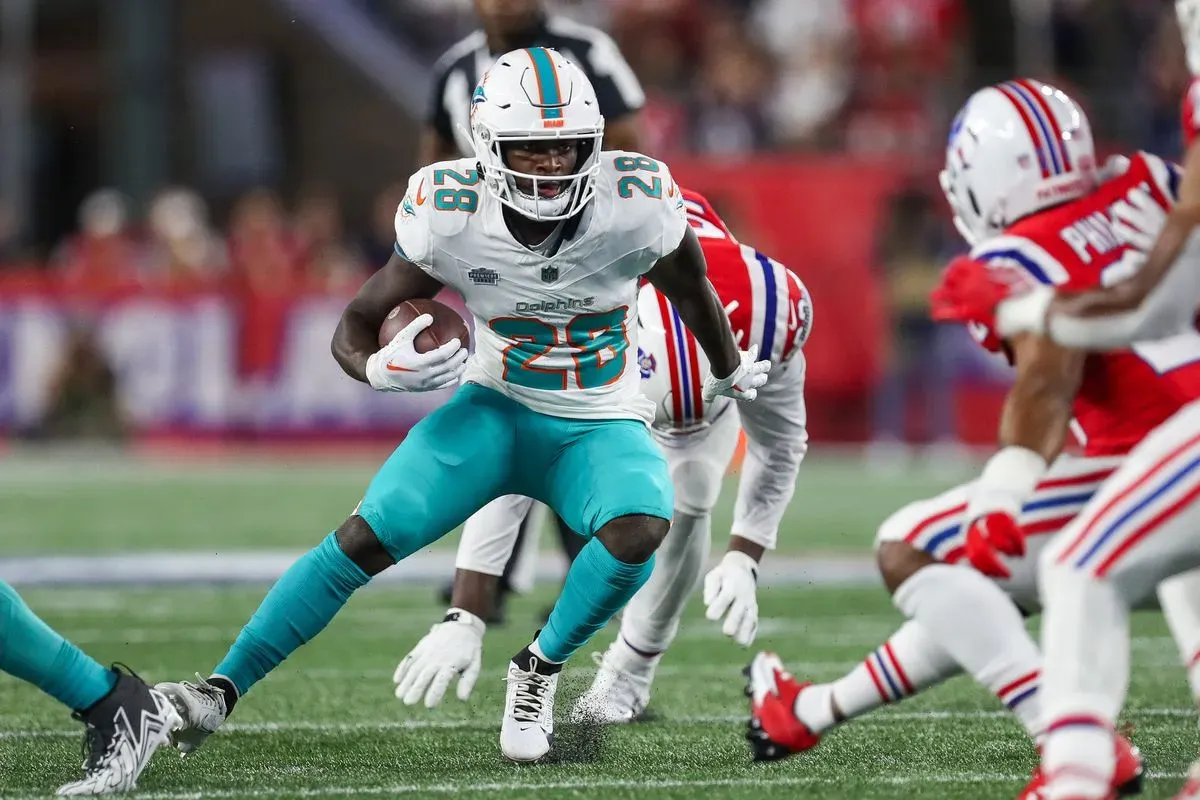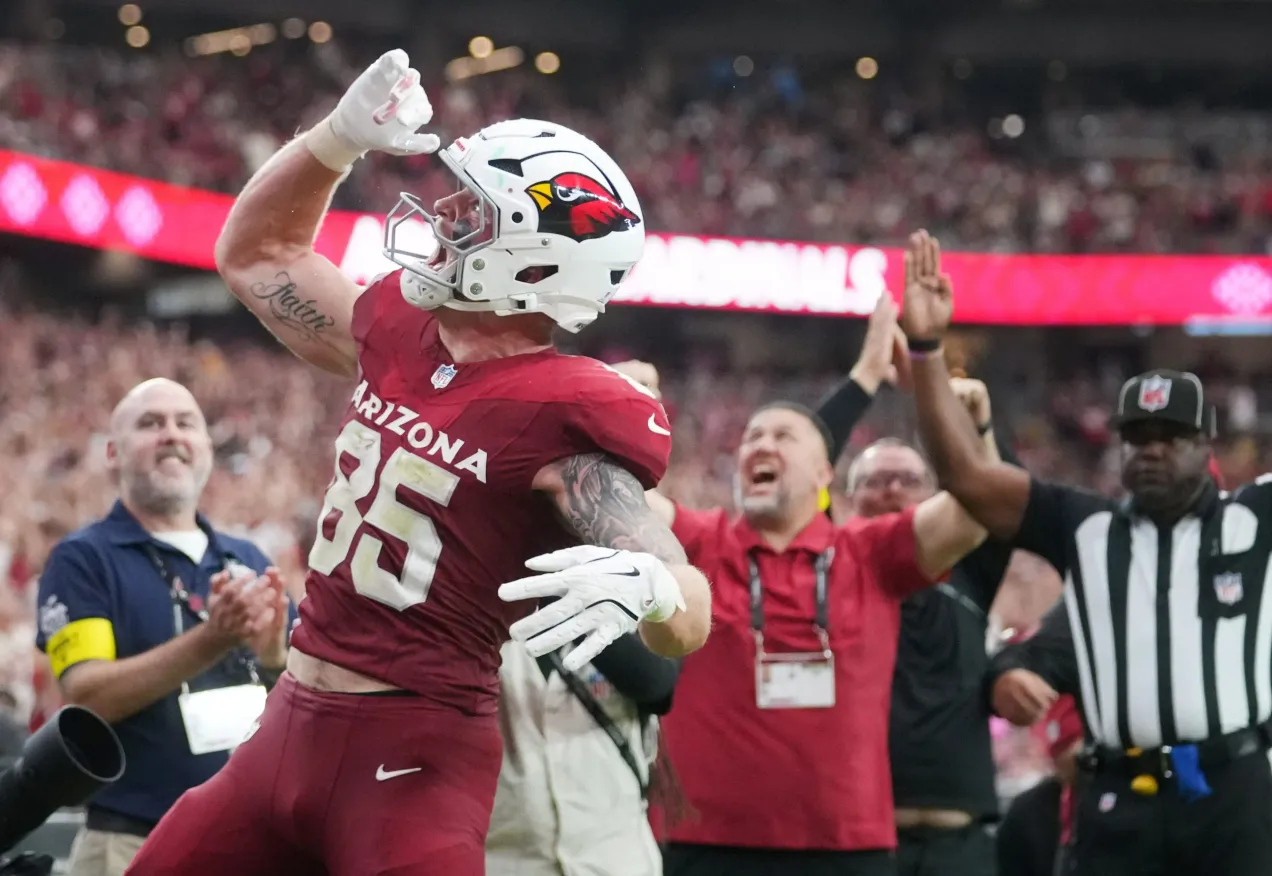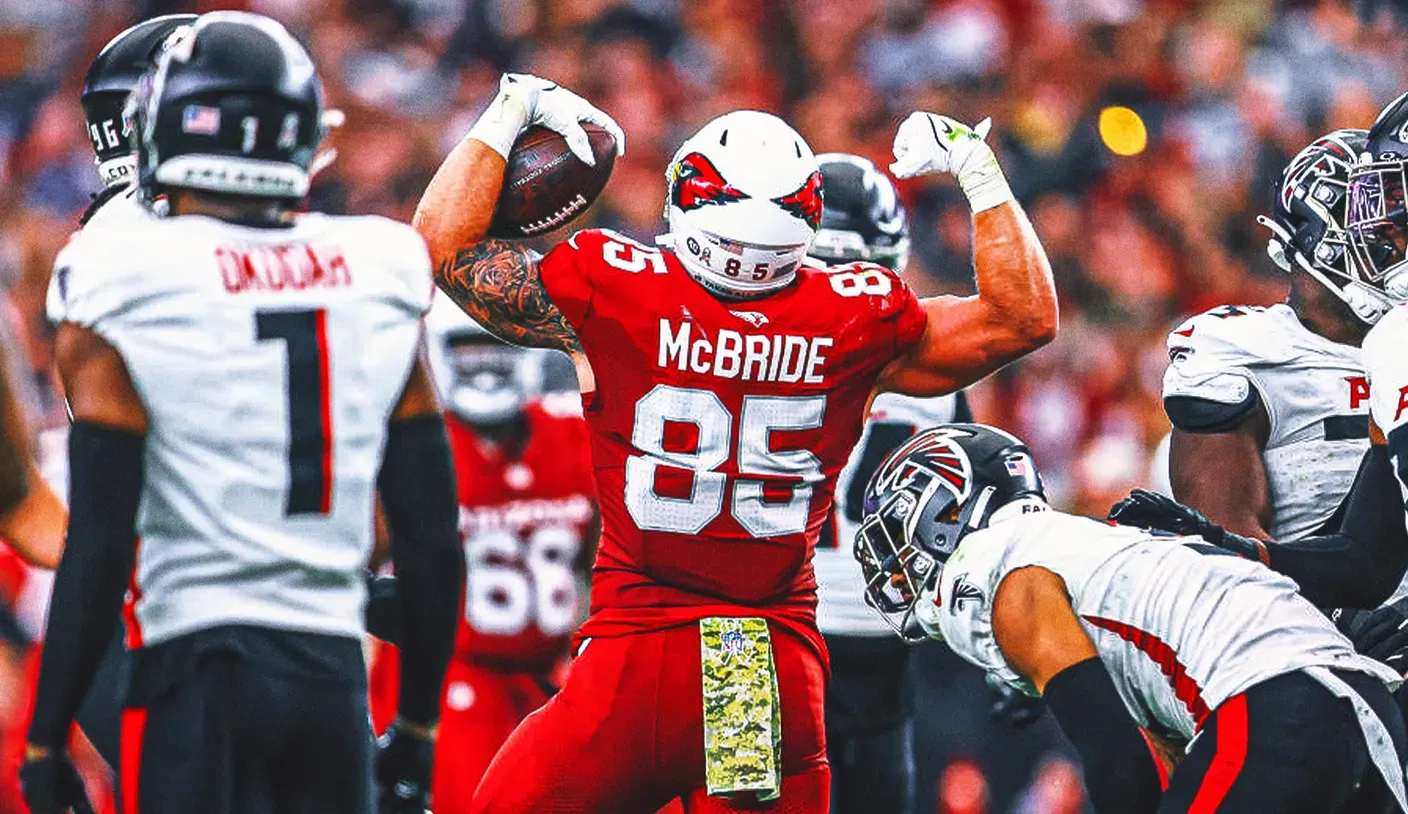
A Framework for Correctly Applying Regression and Studying Outliers from 2024, Volume 3: Wide Receivers and Tight Ends
Welcome to Volume 3—the final edition of the TD regression series. In this edition, we’ll be analyzing WRs and TEs.
In Volume 1, we used regression to better understand QB TD production, where high volume creates larger samples, smoothing out volatility and enhancing the signals. In Volume 2, we shifted to RBs, where fewer opportunities introduced more variance. Still, regression analysis for RBs can prove useful, especially when contextualized around usage patterns, efficiency, and role stability. This time, the signals get even murkier. The samples shrink further. TD totals swing wildly on the back of just a few high-leverage plays.
It’s tempting to apply the same regression lens to chase the symmetry of a clean, data-driven narrative. But the numbers don’t cooperate. WRs and TEs operate in high-variance ecosystems: game script, coverage, route depth, QB trust or health, and red-zone design all introduce chaos. One 80-yard busted coverage or two goal-line targets can turn a fringe player into a seasonal outlier. That doesn’t mean regression is useless; we must treat it with humility.

The good news, especially for WRs, is that other measures are more stable. Metrics like EP, targets, market share, YPRR, YPT, air yards, open score, and even broken tackle percentage tend to be reasonably predictive for future production, especially when they harmonize with each other. Therefore, the information we glean from TD regression should be suppressed in favor of more reliable metrics, especially at WR.
However, that doesn’t mean there is nothing here at all. TDOE (TDs Over Expected), our guiding stat for this series, still flags interesting cases—players scoring far more (or less) than their opportunity would suggest. As is always the case with TD regression, the most reliable signal is in extreme outliers.
THE OVERACHIEVING WIDE RECEIVERS AND TIGHT ENDS
As I did with QB and RB, I’d like to explain what we are looking at with this graphic. All players in the table must have at least 40 Opportunities (rushing attempts + targets) to qualify. Total YDs and TDs combine rushing and receiving stats. To the right of PPR, TDs/YDs are rounded to the thousandth to make the numbers less overwhelming. The league base rate is the average of these values.
Expected TDs are calculated by multiplying the league base rate by a player's total yardage. TDOE is the difference between actual and expected TDs. The result is a z-score, where values further from zero indicate more meaningful outliers, roughly half above and half below zero.
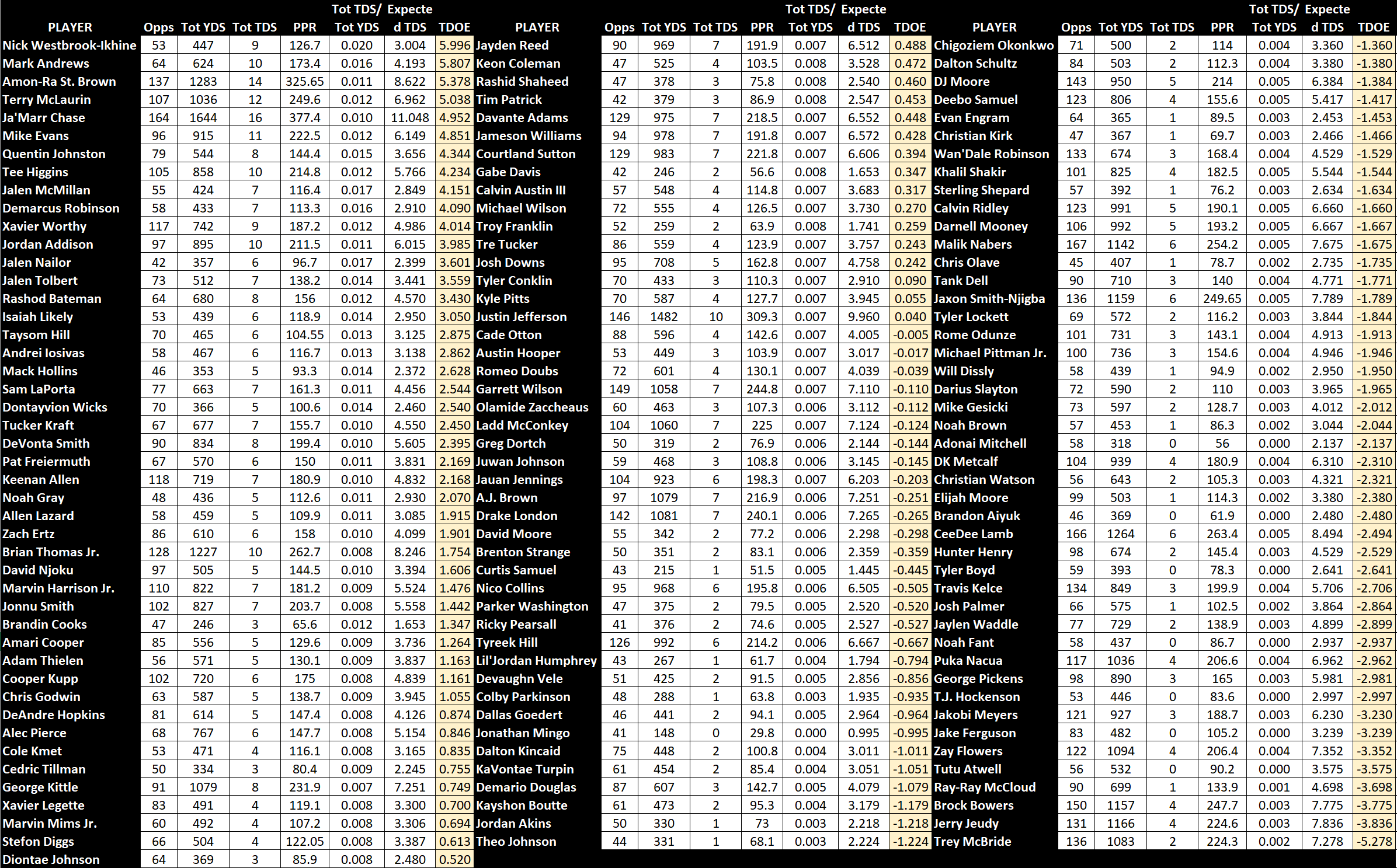
AMON-RA ST. BROWN (Underdog ADP: WR8)
Amon-Ra St. Brown has delivered three straight Top-7 fantasy finishes in full-season PPR, as he finished seventh in 2022, third in 2023, and second last year. During that span, he’s ranked between fourth and eighth in EP, making him a consistently safe WR1 option.
A career-high in targets and target share fueled St. Brown’s 2023 surge into the top three. In 2024, his opportunity reverted to 2022 levels, but a spike in touchdown rate kept his production near the top. In the end, the shifts in usage and scoring balanced out, keeping him planted near the positional apex.

While a regression in touchdown rate and TDOE is expected, St. Brown has more than enough stabilizing metrics to keep him near the top of the wide receiver ranks. In 2024, he finished top-10 in targets, receptions, yardage, EP, FPOE, market share, 1D/RR, and quarterback rating on targets—all strong, predictive anchors.
St. Brown appears poised to spend his prime years as a consistently elite fantasy asset. The only question is how high he will go. Even if his touchdown production dips, he should remain a solid contributor, though perhaps not the league-altering force he’s been the past two seasons.
With Ben Johnson departing for Chicago, there’s also some uncertainty around Detroit’s offensive structure. Still, at his current ADP, it’s hard not to see St. Brown as possibly even a slight value. He’s being drafted lower than he’s finished each of the past three seasons. Draft him with confidence.
MARK ANDREWS (Underdog ADP: TE8)
Since he was drafted in the same class as Lamar Jackson, Andrews has been the two-time MVP’s weapon of choice, and he has long been reliably near the top of the TE charts, even finishing as the TE1 overall in 2021. He started slowly last year, often yielding to Isaiah Likely, Zay Flowers, and Rashod Bateman. But by season’s end, he was still TE6, salvaging his value for fantasy managers who took him in the early-middle rounds.
So, business as usual?
Not exactly. There were cracks. He dropped to 25th in EP/G, 20th in targets, and 15th in weighted opportunity. His 15% target share was his lowest since his rookie season, only the second time it fell below 20%. His 1.88 YPRR—while at least respectable—was also his lowest since his rookie 2018 campaign, and his third consecutive season below 2.0. His targets and yards per game also took significant hits.
What kept Andrews afloat in PPR? Frankly, a remarkable amount of TD production. Andrews led TEs in TD scoring last year despite tying his injury-shortened 2023 for the fewest targets of his career. His TD rate zoomed to 16.3%, also among the top 10 highest rates among WRs and TEs since 2000.
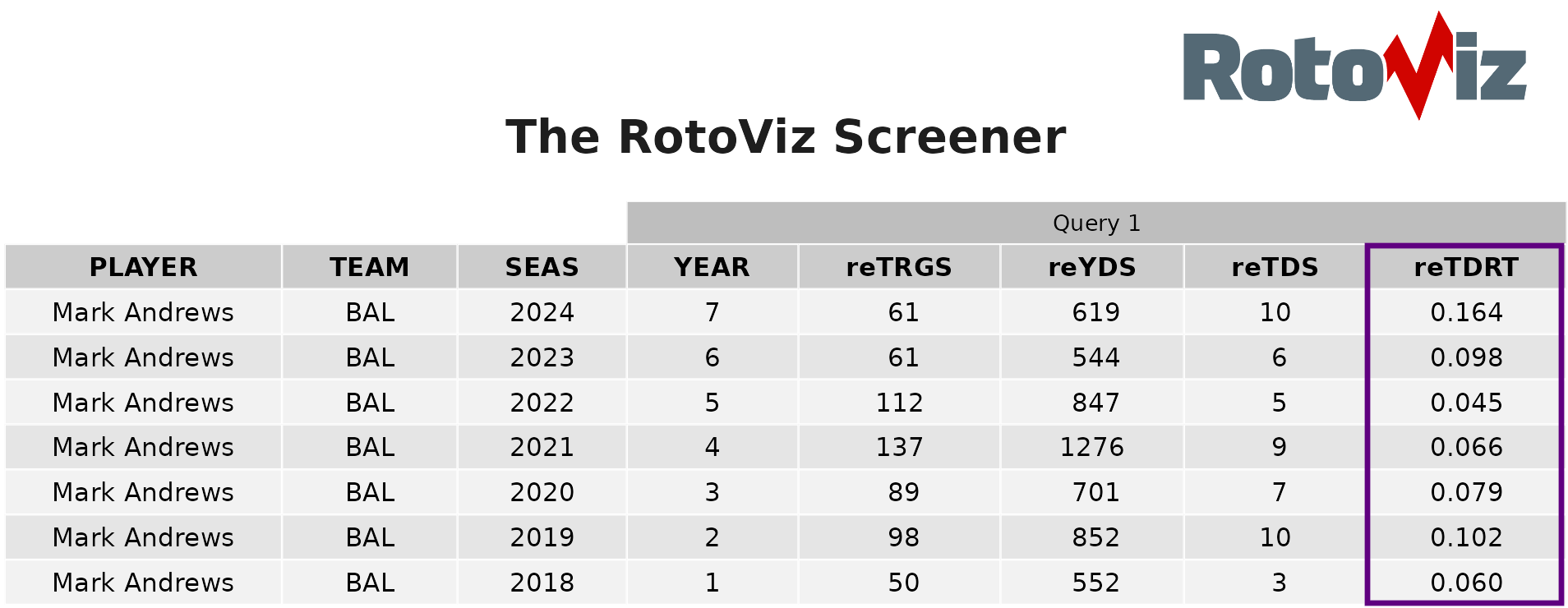
Andrews's 2024 struggles warrant deeper context. He was gradually recovering from a 2023 fibula fracture and ligament tear (he returned for a playoff cameo in 2023 but failed to make an impact), and a strategic shift toward in-line usage, likely tied to early-season offensive line instability. Also, it is notable that Andrews finished 2024 at seventh among all WRs and TEs in ESPN Open Score and tenth in 1D/RR, which are stable and predictive metrics. Andrews’s 141.0 QB rating on targets was third in the NFL.
Yet the core narrative remains unavoidable: a 30-year-old TE hemorrhaging volume metrics while clinging to outlier TD efficiency, in an offense that no longer orbits around him.
This may not be a blip—it may be gravitational pull.
The age cliff looms, but his anomalous 11-TD campaign has artificially propped his dynasty value, creating a fleeting sell window for managers seeking to exit before the floor drops.
NICK WESTBROOK-IKHINE (Underdog ADP: Undrafted)
There is no WR/TE where TD regression should have a more significant impact from 2024 to 2025 than with Nick Westbrook-Ikhine. Westbrook-Ikhine has enjoyed a fairly decent TD rate throughout his career, but his 17.0% TD rate in 2024 was 2.5 times higher than his previous career best.

Not only was Westbrook-Ikhine’s 17.0% TD rate a career best, but it also ranks as the sixth-highest posted by any WR or TE since 2000. In every other case, excluding Westbrook-Ikhine and Mark Andrews in 2024, who naturally have no Year N+1, the rate declined, often sharply. The only player to sustain a remotely similar TD rate the following season was Rob Gronkowski, a generational all-purpose TE who consistently carried an elevated scoring profile. Westbrook-Ikhine is one of just three WRs on the list, and his 2024 mark stands as the highest single-season TD rate for any WR during that span.
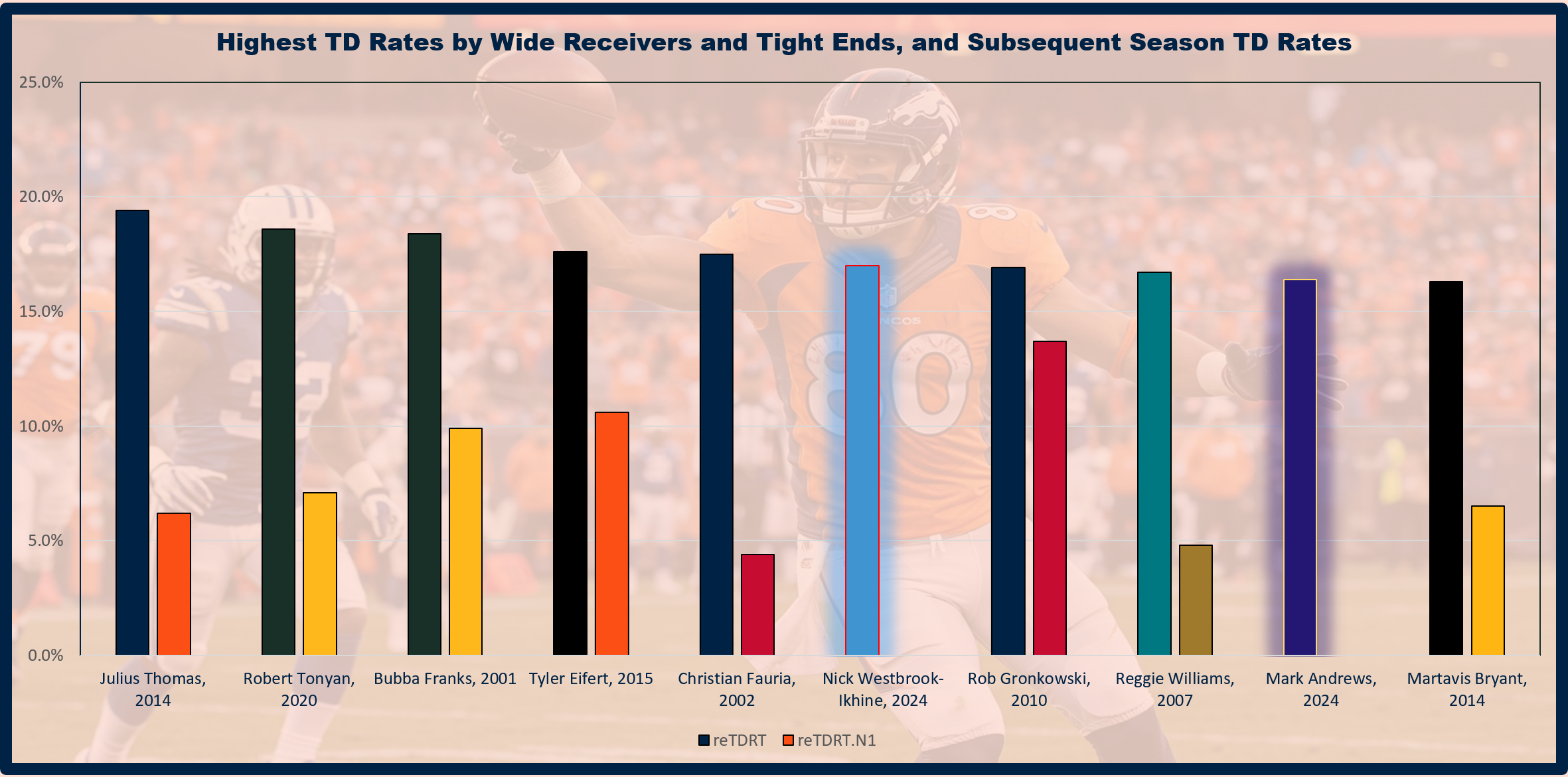
Westbrook-Ikhine totaled just 53 receptions last season. He holds a pedestrian career 1.12 YPRR, including a nearly identical 1.14 single-season rate in 2024. He’s never ranked higher than 75th in Expected Points (EP). His FPOE was a sterling 36.5 last year. And while I caution against using FPOE in isolation as a naked regression signal, this is a case where inflated TD production clearly drove the spike. He's generally hovered above zero in FPOE (which is usually more common for deep area specialists at WR). However, last season's mark exceeded his previous career best by 25.3 and topped the total of his past four seasons combined. His target market share typically lives in the low teens, and 2024 was no exception. He consistently ranks high in air yards/target, but not necessarily gross air yards. There is nothing in his profile that speaks to heightened stability.
In transitioning from Tennessee to Miami, it’s unclear how he’ll carve out a role or what that might look like. The Dolphins boast a far more potent offense and a superior QB. Still, it’s challenging to envision Westbrook-Ikhine earning a larger share in Miami, where there is far greater talent. He also doesn't often win in the short-to-intermediate range, which was central to Miami’s offensive identity a year ago (he may even be there to open things up for the others).
It feels like Westbrook-Ikhine is almost certainly set to regress in TD production, making him barely rosterable. The fantasy community is already onto this, however, and Westbrook-Ikhine is going undrafted on Underdog.

